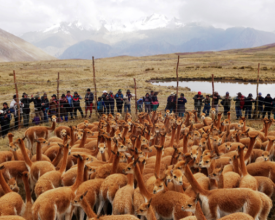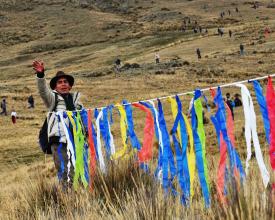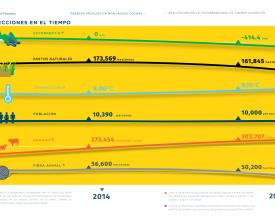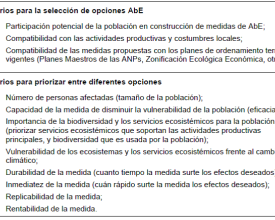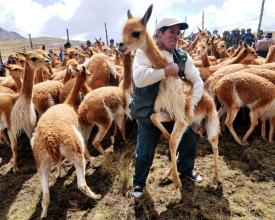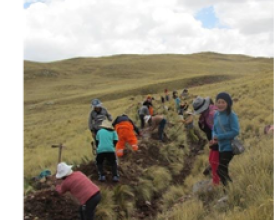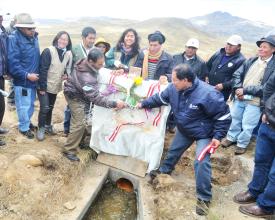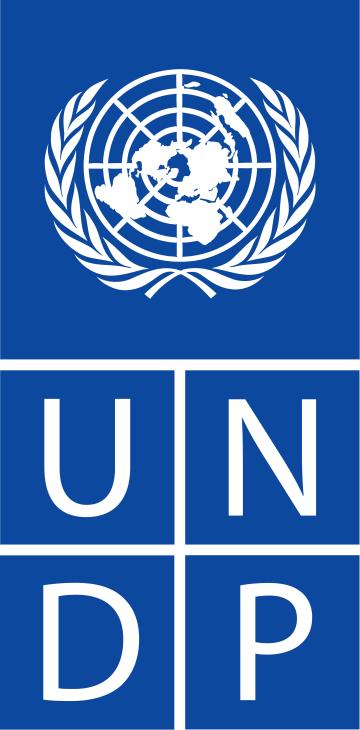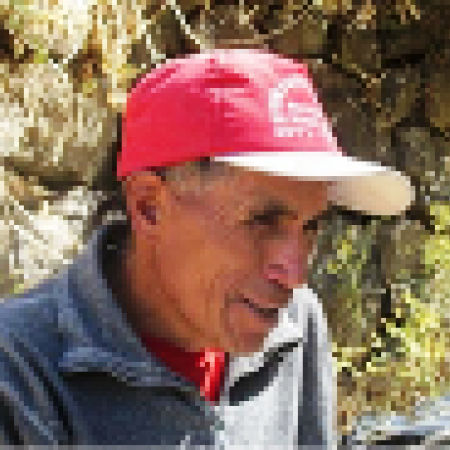
Implementation of EbA measures in the Nor Yauyos-Cochas Landscape Reserve
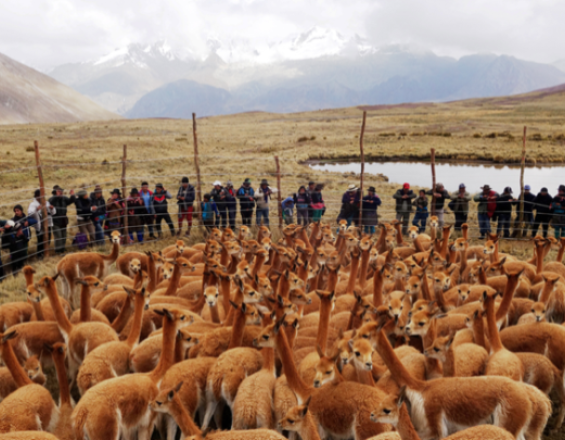
A pilot was implemented to underpin the incorporation of an EbA approach into the planning tools for natural protected areas. The necessary methodologies and tools were developed, the vulnerability assessment was completed, the specific areas and the measures to be implemented were identified, including the communal management of native grasslands, vicuñas management (a wild relative of the llama), the expansion and conservation of wetlands and the restoration of water infrastructure.
Context
Challenges addressed
- Integrate and maintain local knowledge and cultural values, generating benefits at a temporal and spatial level.
- Ensure the participation and involvement of local and regional actors.
- Incorporate the EbA approach into the planning instruments of the protected areas as part of climate change mainstreaming.
- Incorporate the EbA approach into regional strategies for climate change in Junín and Lima as part of the adaptation strategies for regional conservation areas.
- Generate the necessary sound scientific foundation for the implementation of EbA actions through the development of a vulnerability and impact study.
Location
Process
Summary of the process
Three building blocks (BB) form part of the foundation of the EbA measure. The vulnerability and impact study (BB1) is needed for a sound assessment and the development of solid arguments on the vulnerability of the ecosystems to climate change and other current pressures (agricultural practices, mining). It also facilitates the identification of a range of EbA alternatives that could contribute to increase the resilience of these ecosystems and to reduce the vulnerability of human populations.
In order to prioritize among these alternative measures, a list of criteria for the selection of EbA measures was defined in BB2. The criteria helped to ensure that the measures were aligned, contributing to the landscape reserve´s management plan, and that they targeted ecosystem services that were important to the community.
BB1 and BB2 lay the foundation for BB3 – the implementation of EbA measures. Likewise, if the EbA measures have been designed on a sound basis, they should be robust and help ecosystems and populations to adapt to climate change.
Building Blocks
Vulnerability assessment of the protected area
This building block is an essential part of the EbA approach and was carried out prior to the implementation of EbA measures in the Nor Yauyos-Cochas Landscape Reserve. It was considered important to understand the vulnerability to climate change of ecosystems and of populations living in the reserve and whose livelihoods depend directly on the reserve´s ecosystem services.
The objective was to determine the level of sensitivity and the ability to cope with the adverse effects of climate change and extreme events using present observations and future scenarios. Based on the results of these vulnerability and impact studies, the districts with higher vulnerability of ecosystems and ecosystem services -if current management practices would be continued – were identified.
This information served not only to select pilot areas but also to confirm that previously identified EbA measures were adequate to increase resilience of ecosystems to climate change.
Enabling factors
- Availability and access to necessary information, both scientific (climatic, hydrological, etc.) and field information.
- Time: the study required time for data collection and analysis.
- Coordinated work of the actors: SERNANP and Communities
Lesson learned
- Knowing and understanding how vulnerable ecosystems and populations are to climate change is absolutely necessary in order to identify the most appropriate measures to reduce this vulnerability in the future.
- There is no single way to measure vulnerability. The main lesson is that not only a scientific study is required, but a complete and agile and participatory process that generates the quantitative and qualitative information that is needed.
- If the study is very expensive or very complex, it is not replicable. It is necessary to evaluate in advance to what extent the study should be carried out.
Identification of EbA measures
The objective of this building block is to define how to identify the EbA measures to be implemented in the field in order to increase the resilience of ecosystems and population to the adverse effects of climate change. This is important because it explores "how" and "with what" we are going to respond to the identified vulnerability. The identification of criteria for the definition, prioritization and principles for the selection of EbA measures is a tool that allowed clarifying doubts and to reflect, align and define concepts based on the review of relevant documentation, field observations, interviews and discussions with local actors and researchers. The set of criteria was organized into two sections (see gallery). It was first validated by SERNANP and experts and afterwards applied for the prioritization of the EbA measures. Once selected, the proposed measures were validated by the community. We have experienced that it is important not only to validate the results, but also to prioritize the measures in a participatory manner with the communities.
Enabling factors
- Have a set of criteria for the selection of EbA measures that allows a prioritization of possible measures and helps to exclude those that are not EbA.
- Commitment of local actors who will participate in implementation and decision-making.
- Prioritized actions should focus on ecosystem services that are key to the livelihoods of local populations.
- SERNANP and communities working in a coordinated manner.
Lesson learned
- When defining EbA measures, the interlinkages between the population and ecosystem services in the area should be considered. If we choose to work with ecosystems that do not provide ecosystem services for the livelihoods of the target communities, the interventions will not be sustainable. Furthermore, social structures and the strength of local organizations are important.
- It is important that from the very beginning, the project was considered part of SERNANPs activities. While the project has a limited time span in the area, SERNANP is a permanent actor. Once the project ends, SERNANP will be in charge to support, advice and monitor the activities carried out by the communities.
- It requires commitment and willingness of the actors to establish agreements for the sustainability of the processes.
Implementation of EbA measures
The objective of this building block is to implement the EbA measures in the field: community-based grassland management and domestic livestock husbandry associated with management of vicuñas in the wilderness and restoration of ancestral water infrastructure.
In order to start with the implementation of measures, not only the results of the vulnerability and risk assessment were required, but also joint work between the project and the head of the landscape reserve in order to ensure that the measures were articulated and reinforcing the master plan. The prioritization of the EbA measures was carried out jointly with the local communities, who chose the measures according to their interest.
This process was supported by the communal and some district authorities. In addition, trainings were developed for interest groups and park rangers of the landscape reserve, all of this to ensure the implementation, appropriation and sustainability of the activities. Finally, it was important to develop local management plans for each community. These management plans are part of the commitment of each community to continue with the EbA measures. These management plans go hand in hand with the landscape reserve´s master plan.
Enabling factors
- Commitment of the local actors who will participate in the implementation and the decision-making.
- Material and equipment provided by the project to be able to implement the identified measures.
- Capacity building processes for the local actors and the protected area staff for the implementation of EbA.
- SERNANP and communities working in a coordinated manner.
- Dialogue processes and awareness raising at the local level.
Lesson learned
- From the beginning, SERNANP and the project worked together. While the project has a limited time span in the area, SERNANP is a permanent actor. Once the project ends, SERNANP will be in charge to support, advice and monitor the activities carried out by the communities.
- It requires commitment and willingness of the actors to establish agreements for the sustainability of the processes.
- The connection between the population and ecosystem services, as well as the social structures in a community or the strength of local organizations must be taken into account in order to ensure ownership and sustainability.
- It is necessary to sensitize the actors involved, seek a coordinated work with the authorities and devote time to the activities. Implementation itself may be affected by the lack of information, limited availability of resources and lack of support from local authorities or institutions.
Impacts
The project has led to improved management of water from the upper watershed, reducing its scarcity and improving the quality of the pastures. Wetlands were recovered, reducing vulnerability to climate change. At the same time, the local population has more information on climate change and adaptation processes and is organized into interest groups, research groups and also specific committees. Many community members have decided to devote time and effort to make these groups work and to implement the activities proposed by the project. The landscape reserve´s master plan includes for the first-time ecosystem-based adaptation strategies. The participation of the different actors has been strengthened, contributing to the sustainability of the project. Specific standards have been developed, such as grassland and water management plans and regional and national climate change strategies.
Beneficiaries
- Main beneficiaries: SERNANP/landscape reserve team and the local population of Canchayllo, Tanta, Miraflores and Tomas.
- Indirect beneficiaries: Authorities, other communities of the landscape reserve.
Sustainable Development Goals
Story

The project aimed at a better understanding of EbA through the implementing of a pilot measure in a mountain area. The objective was to learn and at the same time generate the necessary information to support the incorporation of the EbA approach into the planning tools of natural protected areas as part of climate change mainstreaming. The project also aimed for a coordinated work between the different actors according to the institutional objectives and according to the existing experience. Alliances were established in order to accompany or facilitate processes.
The objectives were achieved by implementing a set of interrelated activities, grouped around four components. The first component consisted in the assessment and alignment of the project approach and in the process of developing methodologies and tools necessary for the subsequent activities.
As part of the second component, a vulnerability study was completed and the specific areas where to work within the landscape reserve were identified, as well as the measures to be implemented in each case. By this means it was decided that the measures would include the communal management of native grasslands through cattle ranching and associated activities, the vicuñas management for the use of fibre and the expansion and conservation of wetlands and restoration of water infrastructure for the sustainable management of water in the puna (Andean plateau).
The activities of the third component focused on the implementation of measures, and the development of specific guidelines at the level of the landscape reserve and regional governments. The fourth component was to promote the EbA approach outside the landscape reserve and to incorporate it into national policy guidelines, as well as public funding mechanisms.
In addition, activities were carried out to disseminate (information about) the project, seeking to generate impact to enhance sustainability.
A major challenge was the generation of information for the vulnerability and impact study that was indispensable for EbA. The team did not have previous experience with this type of studies, so an external expert was hired to conduct the study. The lack of information made this analysis take longer than planned and the implementation of actions in the field were delayed since the scientific foundation for the implementation of specific measures was missing.
